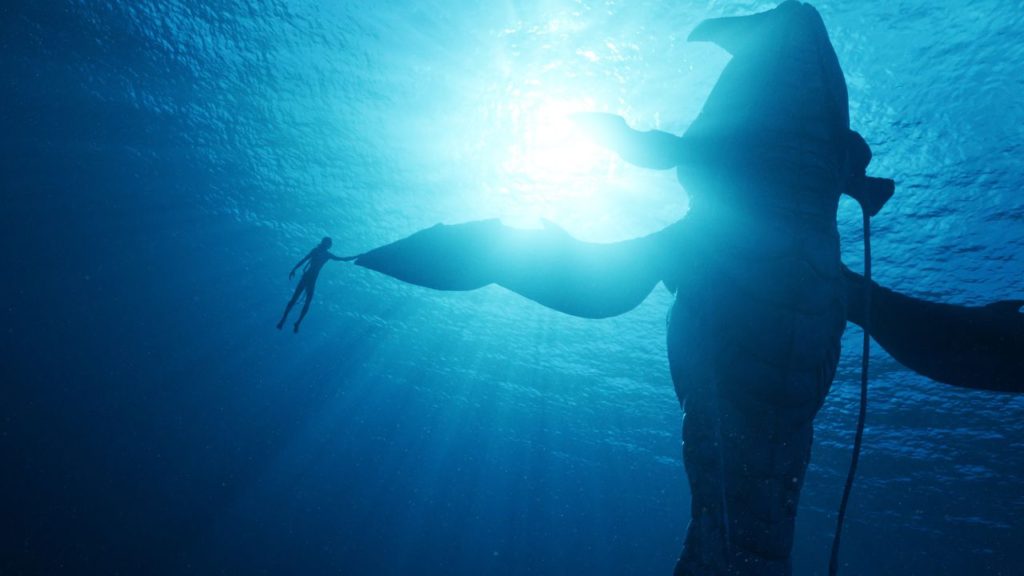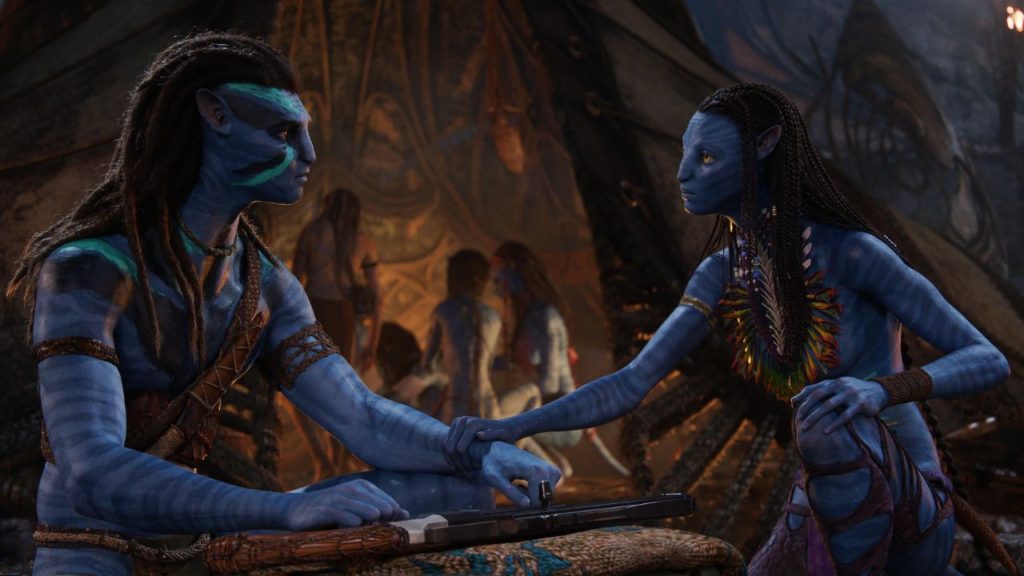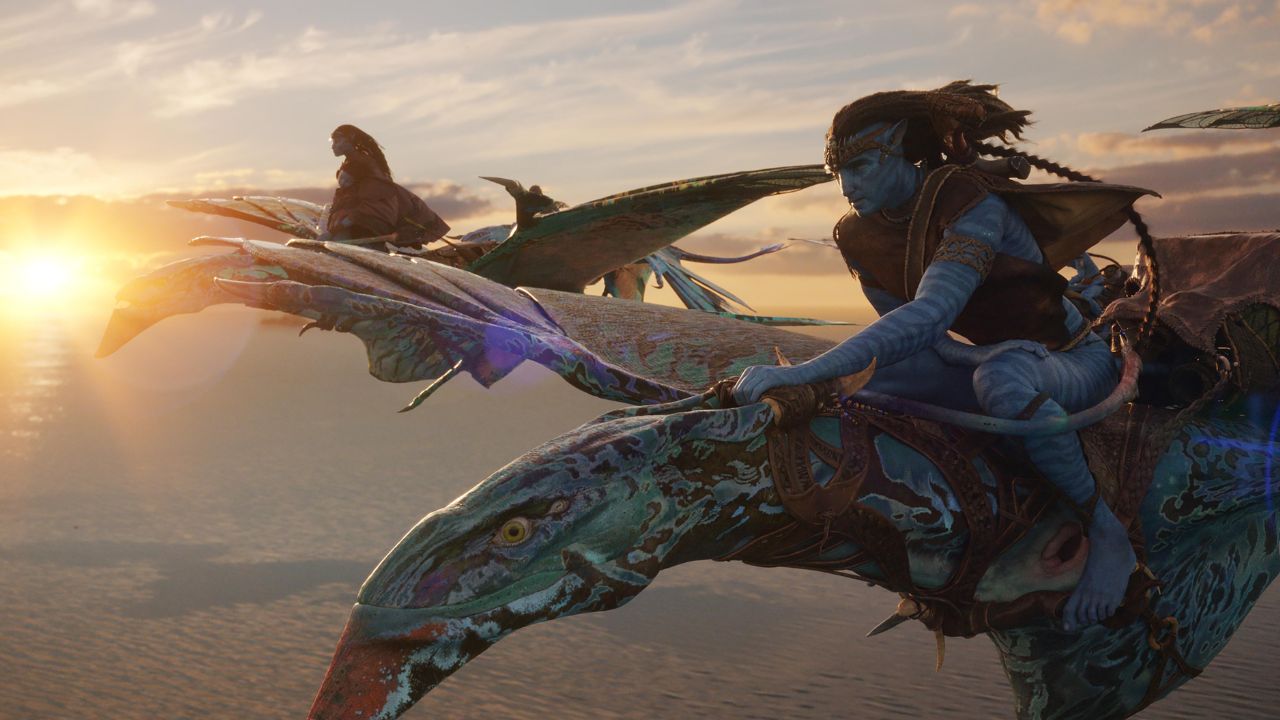Here’s the thing. If we’re stuck spending three hours and 12 minutes watching Avatar: The Way of Water, then it really needs to be completely and utterly immersive. We need to forget ourselves and the world outside. We need to suspend all disbelief and get lost in the narrative. We need to believe in Pandora. That it’s a place worthy of our time. That it’s somewhere worth saving.
Now James Cameron is a very good director. His ability to craft propulsive, breathtaking set pieces is second to none, where every action sequence is infused with character moments, and where technology never plays second fiddle to the human side of filmmaking. He is a fantastic storyteller, and with this movie, he makes a somewhat convincing case for keeping us focussed and glued to our seats for all of that time.
I See You

Set some years after the events of the last movie, Avatar: The Way of Water sees Jake (Sam Worthington) and Neytiri (Zoe Saldaña) raising their gaggle of children in the lush forests of Pandora. They have three of their own – the eldest and predictably conformist Neteyam (Jamie Flatters), the impulsive Lo’ak (Britain Dalton), and baby of the family Tuk (Trinity Jo-Li Bliss) – an adopted daughter, Kiri (Sigourney Weaver), and a straggler in Spider (Jack Champion), a human boy who was abandoned when the Earthlings were kicked off planet at the end of the last movie.
Life is good for them. At least until the violent return of the humans and an enemy they thought was dead. The humans in the movie are reflections of our darkest selves and make for some truly despicable villains. They may not have complex motivations, but they’re the perfect foils for the almost saintly Na’vi. What follows is yet another conflict for natural resources (and revenge!) that pits the humans against the natives.
Fatherhood, however, has made Jake weary of war and he decides that the only way to protect his family is to run. So Jake, Neytiri, and the children leave the forest and reluctantly seek refuge among the Metkayina, a tribe of paler, purpler, ocean dwelling Na’vi, who take them in and teach them the “way of water.”
This sequel is as much a coming of age story for the children as it is Jake’s journey from pacifist to activist. In fact, some of the most interesting aspects of the movie lie in the relationship between the children and how they deal with growing up in the shadow of their alien father. They are outsiders, mongrels in some sense, and that struggle with their identity means that they only have each other to rely on. This new family dynamic, rooted in the notion that “Sullys stick together,” sets up some potentially interesting material for the movies to come.
Wonders Beyond Imagination

All of the same criticisms of the first Avatar movie still apply. There is nothing here that will shock or surprise you. The characters remain archetypal and two-dimensional, with their individual journeys straying little from Joseph Campbell’s tried and tested template. The overarching plot is lovingly cribbed from Le Guin, and Miyazaki, and even Fern Gully, while also leaning heavily on tribal tropes and Hindu mythology. (There are moments in this movie that are also reminiscent of Free Willy. You’ll know it when you see it!)
Narratively, Avatar: The Way of Water, is basic at best. It does just enough to keep you interested. The thing that gets you invested, however, is the spectacle. The epic, sweeping, mythmaking, world-building of it all. That’s what James Cameron is interested in. That’s what inspires him. And it’s what truly elevates this movie.
There’s no escaping the fact that watching Avatar is as much a technological experience as it is a cinematic one. The 3D truly is revolutionary. The CGI and motion capture are so fine tuned that we see actual performances and not just computer generated approximations. There is an intricacy to the way this movie looks. Pandora feels rich, and lush, and lived in. It sings. It shines. It is, in a word, beautiful.
What James Cameron has done here is nothing short of astounding. He takes us into another world in a completely seamless and immersive way. There is an undeniable brilliance in his ability as a director to dive so boldly into alien territory.
Be Like Water

Avatar: The Way of Water isn’t in any way a revolution in storytelling. It does, however, take a bold step forward in revolutionizing how these sci-fi stories can be told. It’s important that Pandora feels as real as it does. It remains the main character in the Avatar universe and is therefore the one element that needs to be absolutely right.
If one of the functions of cinema is to transport us away and provide sheer, unadulterated escapism, then this movie pulls it off in excellent fashion. Avatar: The Way of Water isn’t nuanced by any measure, but there is a lot more dramatic tension and emotion here, which means that it doesn’t just surpass the original on technical merit, but also (even if only slightly) by virtue of its narrative. This is a good movie. It might even be a great one. But we’ll need to wait and see how the others turn out before making that judgment.









Follow Us